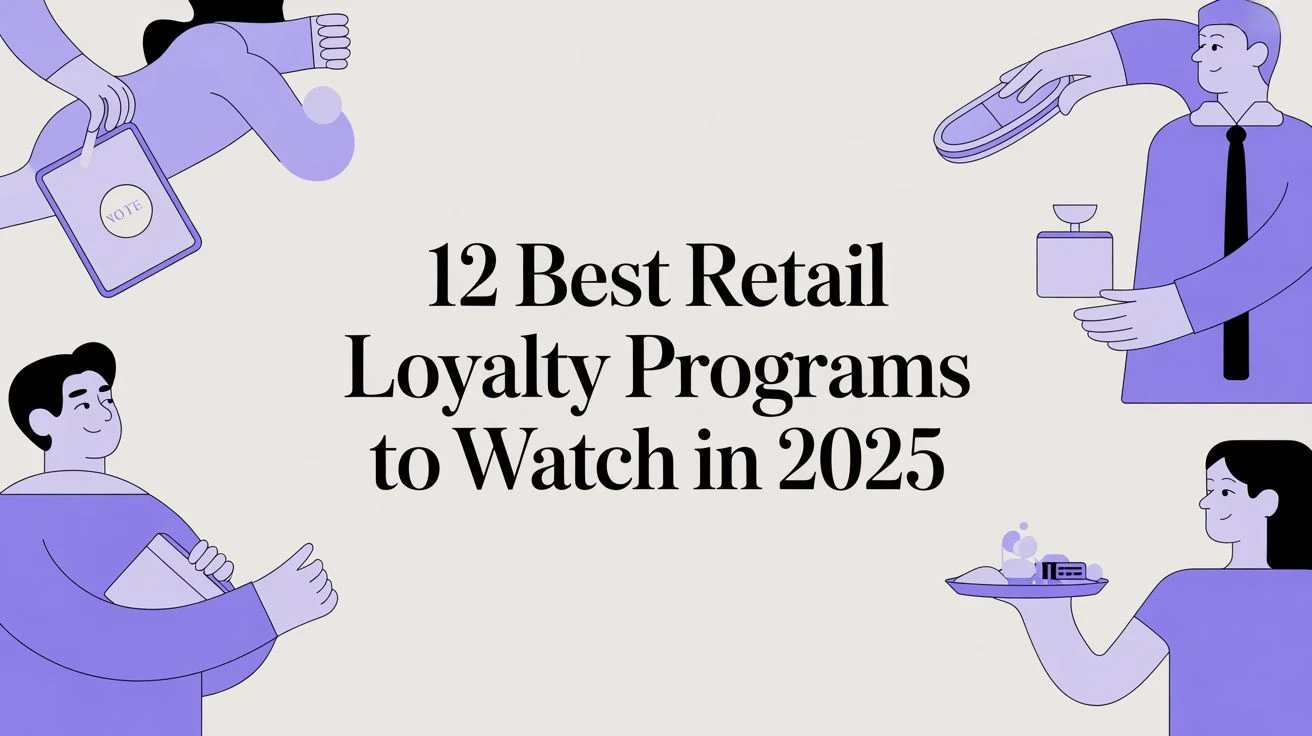In a competitive market, acquiring a new customer can cost five times more than retaining an existing one. The key to sustainable growth isn't just attracting new faces; it's about turning first-time buyers into lifelong advocates. This is where a well-structured loyalty program becomes your most powerful tool, transforming transactional relationships into genuine, lasting connections. However, choosing the right platform from a sea of options can be overwhelming, with features ranging from simple point systems to complex, multi-tiered engagement platforms.
This guide cuts through the noise. We've compiled a comprehensive list of the best retail loyalty programs available, designed to help you find the perfect fit for your business, whether you're a small coffee shop, a growing salon, or a multi-location retail store. We move beyond marketing jargon to provide an in-depth analysis of each platform, detailing its core features, ideal use cases, and practical limitations. For innovative strategies in fostering long-term relationships, exploring how to use technology effectively is crucial; a great starting point is understanding the benefits of using AI chatbots to drive customer loyalty programs.
Forget sifting through generic sales pitches. Inside this resource, you will find:
- Detailed breakdowns of top-tier platforms like BonusQR, Salesforce, and Yotpo.
- Honest pros and cons to guide your decision-making.
- Screenshots and direct links for a clear, hands-on preview of each tool.
Our goal is straightforward: to provide you with the information you need to select a loyalty solution that not only retains customers but also actively contributes to your bottom line. Let’s dive in and find the program that will build your community of loyal fans.
1. BonusQR
BonusQR secures its place as a top contender among the best retail loyalty programs by offering a remarkably flexible and hardware-free solution ideal for small to medium-sized businesses. Its core strength lies in its rapid, five-minute setup process that allows establishments like coffee shops, salons, and independent retailers to launch a sophisticated program using only QR codes and a smartphone. This approach eliminates the need for costly point-of-sale (POS) integrations or additional hardware, making it accessible for businesses on a tight budget.
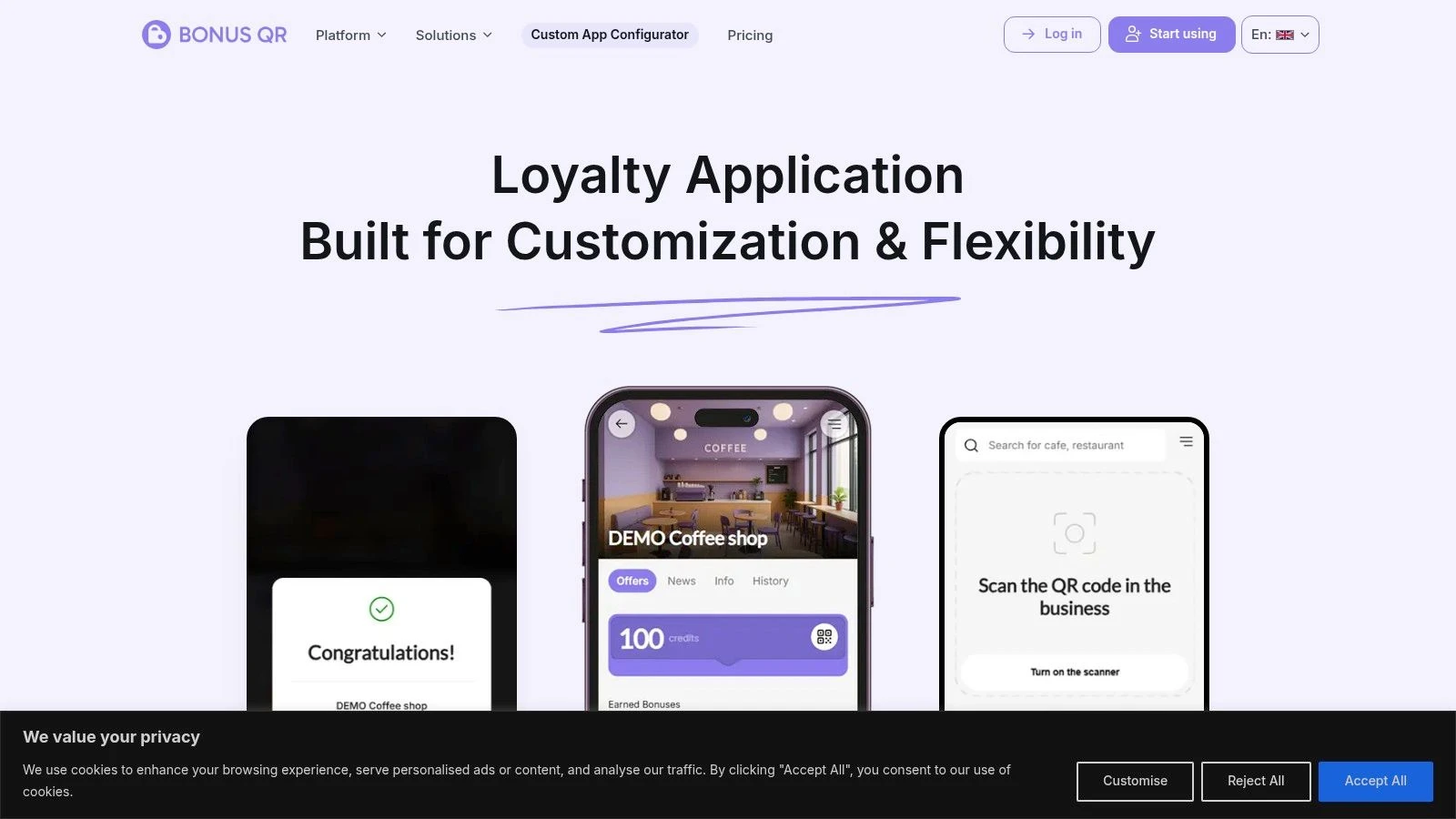
The platform’s standout feature is its modular design. Business owners can mix and match various loyalty mechanics to create a truly bespoke program. Instead of being locked into a single model, you can combine digital stamp cards with a points-based system, or layer cashback rewards on top of spend-threshold bonuses. This adaptability ensures the program aligns perfectly with specific business goals, whether it's increasing visit frequency or boosting average transaction value.
Key Features and Use Cases
BonusQR integrates loyalty with essential marketing and analytics tools, providing a unified dashboard to manage customer relationships.
- Modular Loyalty Logic: Combine loyalty types like stamps, points, cashback, visit-based rewards, and automated occasion coupons (e.g., birthday offers).
- Built-in Marketing Automation: Engage customers directly with automated push notifications and email campaigns. For example, a restaurant can send a "we miss you" offer to customers who haven't visited in 30 days.
- Customer Insights: Track real-time analytics to understand customer behavior, identify top spenders, and measure the ROI of specific promotions.
- Digital Wallet Integration: Customers can add their loyalty card to Google Wallet or Apple Wallet for convenient, contactless access.
- Scalable Branding: Start with a free plan and scale up to a fully branded White-Label app published on the Google Play and App Stores.
Pricing and Implementation
BonusQR offers a tiered pricing structure designed for growth:
- Free Plan: A forever-free option with basic functionality to get started.
- Subscription Plans: Priced at 19€/month and 69€/month, these plans unlock premium features, more marketing capabilities, and greater visibility.
- White-Label & Custom Apps: For businesses seeking a fully branded experience, White-Label options start at a one-time 690€ fee, while custom builds with POS/CRM integrations begin around 1690€.
Implementation is straightforward. The platform provides ready-to-print promotional materials, and staff only need a smartphone to scan customer QR codes at checkout.
Pros:
- Fast, no-hardware setup using QR codes.
- Highly customizable and modular loyalty options.
- Integrated marketing and analytics tools.
- Scalable plans from free to fully custom branded apps.
Cons:
- Advanced POS/CRM integrations are reserved for custom-tier builds.
- The website lacks public customer testimonials or case studies.
Website: https://bonusqr.com
2. Salesforce Loyalty Management
Salesforce Loyalty Management is an enterprise-grade platform designed for complex retail operations that are already integrated into the Salesforce ecosystem. It excels at creating sophisticated, multi-layered programs, including points, tiers, and partner-led coalition models, all natively connected to Sales, Service, and Marketing Clouds. This deep integration is its core differentiator, allowing retailers to craft highly personalized offers and benefits in real-time based on a complete 360-degree view of the customer.

Unlike many SMB-focused tools, Salesforce is built for scale, making it one of the best retail loyalty programs for multi-brand corporations or franchises needing robust governance and the ability to manage several distinct programs within a single organizational structure. Its powerful, low-code rule engine allows marketers to configure complex accrual, redemption, and tier-based logic without heavy developer involvement.
Key Features and Considerations
The platform's strength lies in its ability to leverage existing customer data for maximum impact. For instance, a retailer can use Service Cloud data to automatically award loyalty points for a positive customer support interaction or use Marketing Cloud journeys to trigger personalized promotions when a member is close to reaching the next tier. This level of automation can significantly transform your business with digital loyalty solutions by creating a seamless customer experience.
Pros:
- Deep CRM Integration: Unparalleled connection to customer data for businesses already using Salesforce.
- Published Pricing: Transparent, predictable costs make enterprise-level budgeting straightforward.
- Powerful Ecosystem: Access to a vast network of system integrators and partners for implementation and support.
Cons:
- High Entry Price: The cost is prohibitive for small or medium-sized businesses.
- Platform Dependency: Delivers maximum value only when a business is committed to the Salesforce platform.
Website: https://www.salesforce.com/products/loyalty-management/overview/
3. Oracle CrowdTwist Loyalty & Engagement
Oracle CrowdTwist is a mature, full-featured loyalty and engagement platform designed for large-scale retailers seeking to build sophisticated, omnichannel programs. It excels at rewarding customers not just for purchases, but also for a wide range of brand interactions, such as social media engagement, survey responses, and content consumption. This engagement-first approach, combined with robust support for complex loyalty models, makes it a powerful tool for enterprises already invested in the Oracle ecosystem.

Unlike simpler, SMB-focused solutions, CrowdTwist is built to handle the complexities of multi-brand corporations and global retailers. Its deep integration with the Oracle CX stack, including Responsys and the Unity CDP, allows for highly coordinated and data-driven loyalty marketing. Features like partner management and householding provide the flexibility needed for intricate program structures, making it one of the best retail loyalty programs for enterprises aiming to unify customer data across their entire technology stack.
Key Features and Considerations
The platform's strength is its ability to create a holistic view of customer engagement and translate it into loyalty. Deployable widgets for member portals and sign-ups accelerate implementation, while self-service business intelligence dashboards empower marketers to analyze program performance and export data without IT dependency. This allows for agile decision-making and continuous program optimization based on real-time customer behavior.
Pros:
- Mature Enterprise Capabilities: Robust features for gamification, rewards catalogs, and non-transactional engagement.
- Strong Integration: Natively connects with the Oracle CX stack for a unified customer profile.
- Complex Program Support: Ideal for managing multi-brand, partner, and householding loyalty structures.
Cons:
- Enterprise-Led Evaluation: The purchasing process is quote-based and requires significant stakeholder involvement.
- Platform Dependency: Delivers the most value for businesses already using Oracle CX, Unity, or Responsys.
Website: https://www.oracle.com/industries/customer-loyalty/
4. SAP Emarsys Customer Engagement (with native Loyalty)
SAP Emarsys Customer Engagement is an omnichannel marketing platform with a native loyalty solution designed for retail marketers. Its primary strength is the tight integration between its marketing automation and loyalty features, allowing businesses to orchestrate highly personalized campaigns. The platform uses AI-driven segmentation and a library of prebuilt "tactics" or playbooks to help retailers quickly launch sophisticated, loyalty-infused customer journeys across email, mobile, and web.
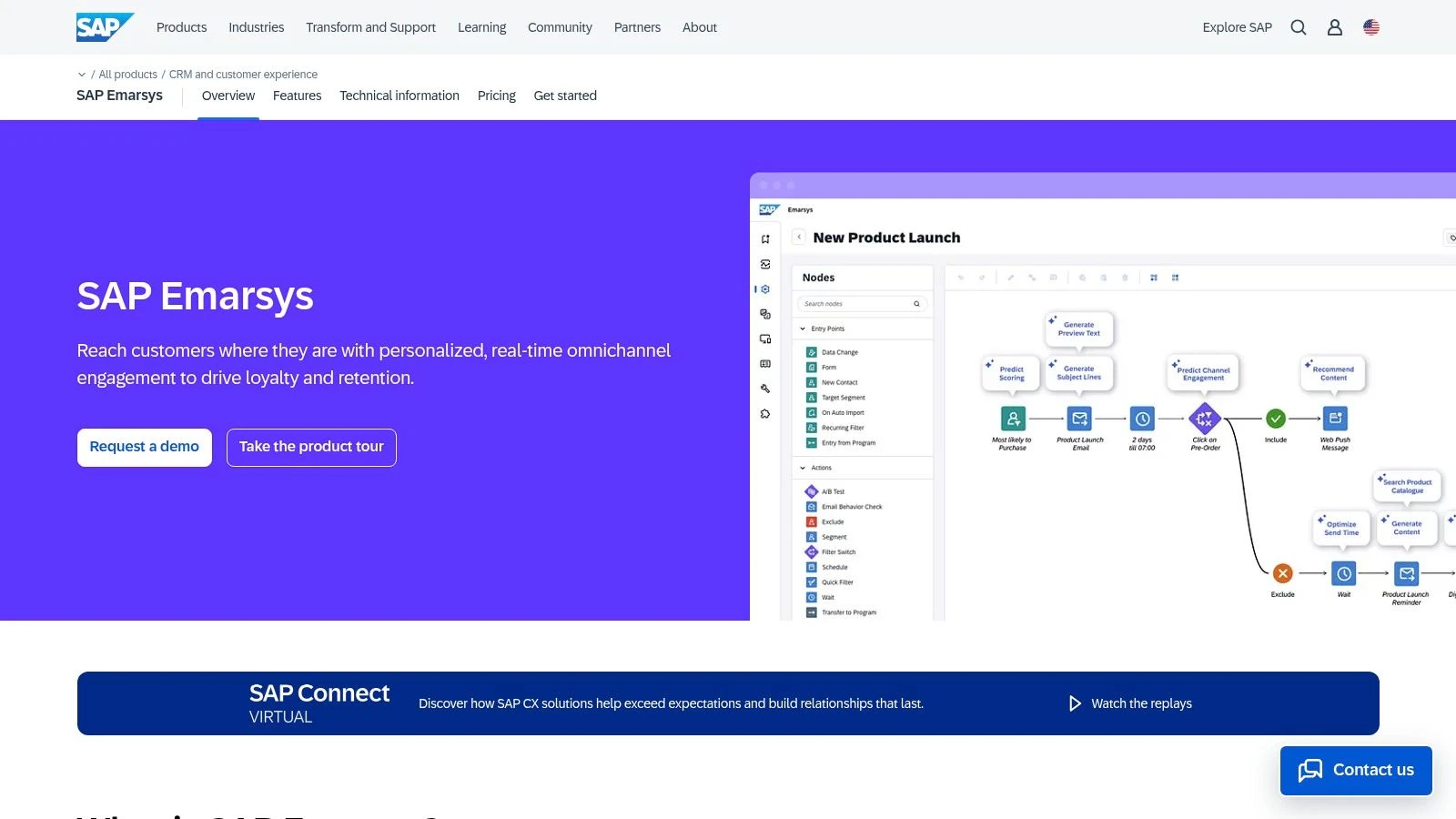
Unlike standalone loyalty systems, Emarsys treats loyalty as a core component of the overall customer engagement strategy, not an afterthought. This makes it one of the best retail loyalty programs for marketing teams who want to embed points, rewards, and tier status directly into their communication workflows. For retailers needing more advanced loyalty features like coalition programs or complex B2B scenarios, the platform can be extended through partner integrations.
Key Features and Considerations
The platform excels at using loyalty data to trigger real-time personalization. For example, a marketer can easily create an automated campaign that sends a push notification with a bonus point offer to a high-value customer segment that has not purchased in 30 days. This unified approach simplifies reporting and allows for a holistic view of how loyalty impacts customer lifetime value and channel engagement.
Pros:
- Retail-Centric Playbooks: Quick-to-launch tactics and prebuilt journeys designed specifically for retail use cases.
- Strong Marketing + Loyalty Connection: Seamless orchestration of loyalty elements within broader marketing campaigns.
- AI-Driven Personalization: Leverages artificial intelligence for advanced customer segmentation and real-time offer delivery.
Cons:
- Pricing by Quote: Costs are not public and depend heavily on selected modules and usage volume.
- Platform Dependency: Provides the greatest value when Emarsys is used as the central customer engagement hub.
Website: https://www.sap.com/products/crm/emarsys.html
5. PAR Punchh (PAR Engagement - Loyalty)
PAR Punchh is a market-leading loyalty and offers platform with a sharp focus on the restaurant, quick-service restaurant (QSR), and convenience retail sectors. Its strength lies in creating deeply integrated, mobile-first engagement strategies that connect directly with point-of-sale (POS) and online ordering systems. This specialization makes it a go-to choice for large US chains that prioritize a seamless customer journey from the mobile app to in-store pickup.
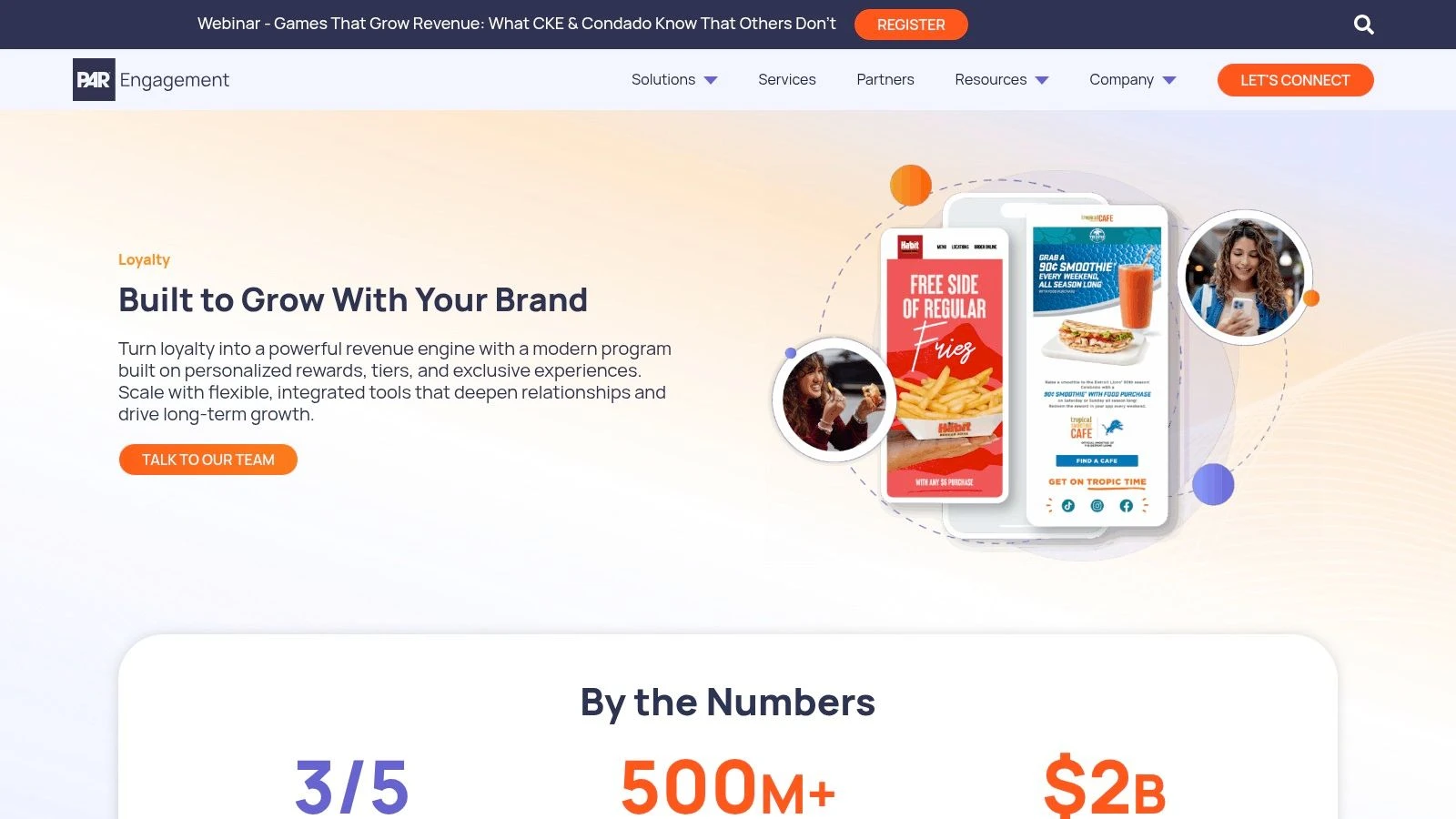
Unlike general-purpose loyalty tools, Punchh is engineered for the high-transaction, high-frequency environment of food and beverage. It supports everything from points and tiers to sophisticated offer targeting, gamification, and even subscription models. Its ability to leverage AI for personalization allows brands to deliver relevant offers that drive repeat visits and increase average order value, cementing its position as one of the best retail loyalty programs for its niche.
Key Features and Considerations
The platform excels at unifying the digital and physical customer experience through its extensive integration network, which includes over 200 partners like Apple Wallet and Google Wallet. This allows for effortless loyalty accrual and redemption, whether a customer orders via a mobile app, a third-party delivery service, or at the counter. The inclusion of enterprise services and strategic support helps large organizations deploy and manage complex loyalty initiatives effectively.
Pros:
- Proven at Scale: A dominant force in the US QSR and convenience segments with a massive installed base.
- Deep POS/Ordering Integrations: Unmatched connectivity with major restaurant and retail technology stacks.
- Exceptional Mobile UX: Strong focus on creating a seamless and engaging mobile user experience.
Cons:
- Pricing Not Public: Requires an enterprise sales motion, making it inaccessible for smaller businesses.
- Restaurant-Heavy Focus: Less tailored for pure e-commerce or traditional non-food retail operations.
Website: https://punchh.com/solutions/loyalty/
6. Paytronix
Paytronix is an all-in-one guest engagement platform specifically engineered for restaurants, convenience stores, and other foodservice businesses. It differentiates itself by tightly bundling loyalty, online ordering, customer relationship management (CRM), and payment processing into a single, cohesive system. This integrated approach is ideal for organizations seeking to reduce vendor complexity and gain a holistic view of customer behavior across all touchpoints.

Unlike general-purpose loyalty tools, Paytronix is purpose-built for the high-frequency, quick-service environment. Its platform excels at driving repeat visits through features like visit-based challenges, instant-win games, and subscription programs. The system provides powerful, real-time reporting on ROI and cohort performance, making it one of the best retail loyalty programs for data-driven operators who need to measure the direct financial impact of their marketing efforts.
Key Features and Considerations
The platform's strength is its ability to create a seamless guest experience from order to reward. For example, a restaurant can use the self-service loyalty builder to create a "buy 5, get 1 free" coffee challenge that automatically tracks progress through integrated point-of-sale (POS) and first-party ordering apps. This vertical-specific functionality, backed by a strong services team and industry benchmarks, helps businesses launch effective, proven loyalty strategies quickly.
Pros:
- Reduces Vendor Sprawl: Combines loyalty, ordering, and CRM into a single, unified platform.
- Strong Services Team: Offers access to industry benchmarks, case studies, and expert guidance.
- Industry-Specific Focus: Deeply optimized for the unique needs of restaurants and convenience stores.
Cons:
- Pricing Not Published: Costs vary based on modules and scale, requiring a direct sales inquiry.
- Niche Vertical Focus: Less suitable for general retail businesses outside of foodservice or c-stores.
Website: https://www.paytronix.com/platform/loyalty/
7. Annex Cloud (Loyalty Experience Platform)
Annex Cloud provides an enterprise-grade Loyalty Experience Platform designed for global retailers and CPG brands that require sophisticated, omnichannel programs. Its core strength is a highly flexible, API-first architecture that allows businesses to build unique loyalty solutions beyond simple points and tiers. The platform excels at integrating complex earning rules, including transactional, behavioral, and social actions, into a unified customer experience across all touchpoints.
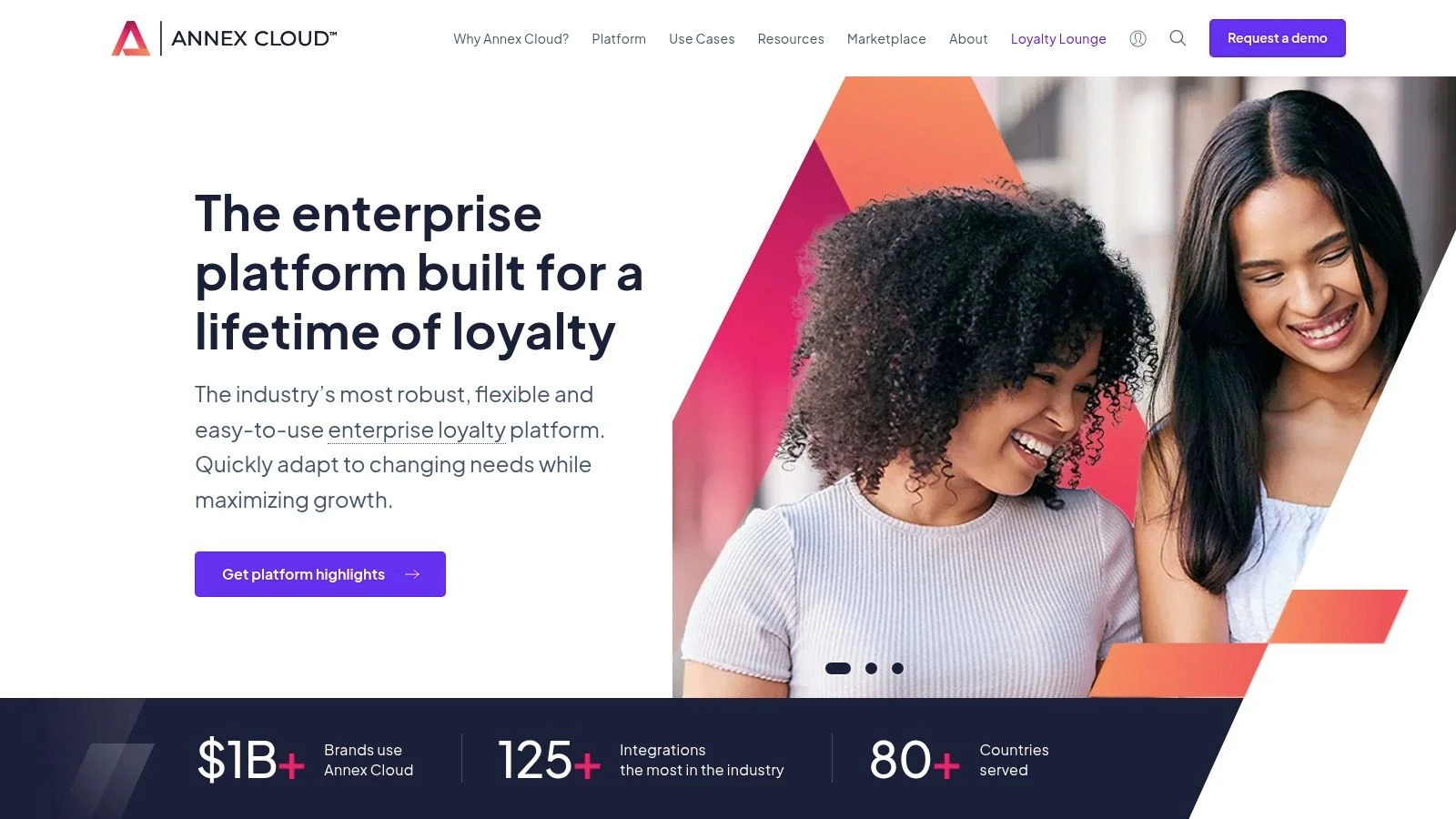
Unlike out-of-the-box solutions, Annex Cloud is built for customization and scale, making it one of the best retail loyalty programs for large, multi-region businesses needing to capture extensive zero-party and first-party data. Its powerful rules engine supports advanced gamification, referral marketing, and user-generated content, enabling brands to reward a wide range of value-driving customer behaviors, not just purchases. This adaptability is key for companies looking to differentiate through their loyalty strategy.
Key Features and Considerations
The platform's 125+ pre-built integrations and robust API facilitate deep connections with a brand's existing tech stack, from ESPs like Emarsys to CDPs and e-commerce platforms. This allows for the creation of truly personalized experiences based on a comprehensive customer profile. For instance, a retailer can reward customers for leaving reviews, engaging on social media, or completing surveys, with all data flowing back into their marketing systems for further segmentation and targeting.
Pros:
- Enterprise Scalability: Built to handle high volumes of transactions and members for global brands.
- High Configurability: A flexible rules engine allows for truly unique and complex program designs.
- Strong Partner Ecosystem: Features native integrations and a vast network for seamless implementation.
Cons:
- No Public Pricing: Requires a detailed discovery and solutioning process to determine cost.
- Implementation Time: Complex setups demand significant stakeholder alignment and resources.
Website: https://www.annexcloud.com/
8. Antavo Loyalty Cloud
Antavo Loyalty Cloud is a composable, API-first platform designed for retailers looking to move beyond simple discounts and points. It specializes in building experiential and lifestyle-oriented loyalty programs, making it a top choice for fashion, beauty, and specialty retail brands that want to foster a deeper emotional connection with their customers. Its key differentiator is its focus on non-transactional rewards, such as challenges, badges, and community engagement, powered by a sophisticated promotion and loyalty engine.
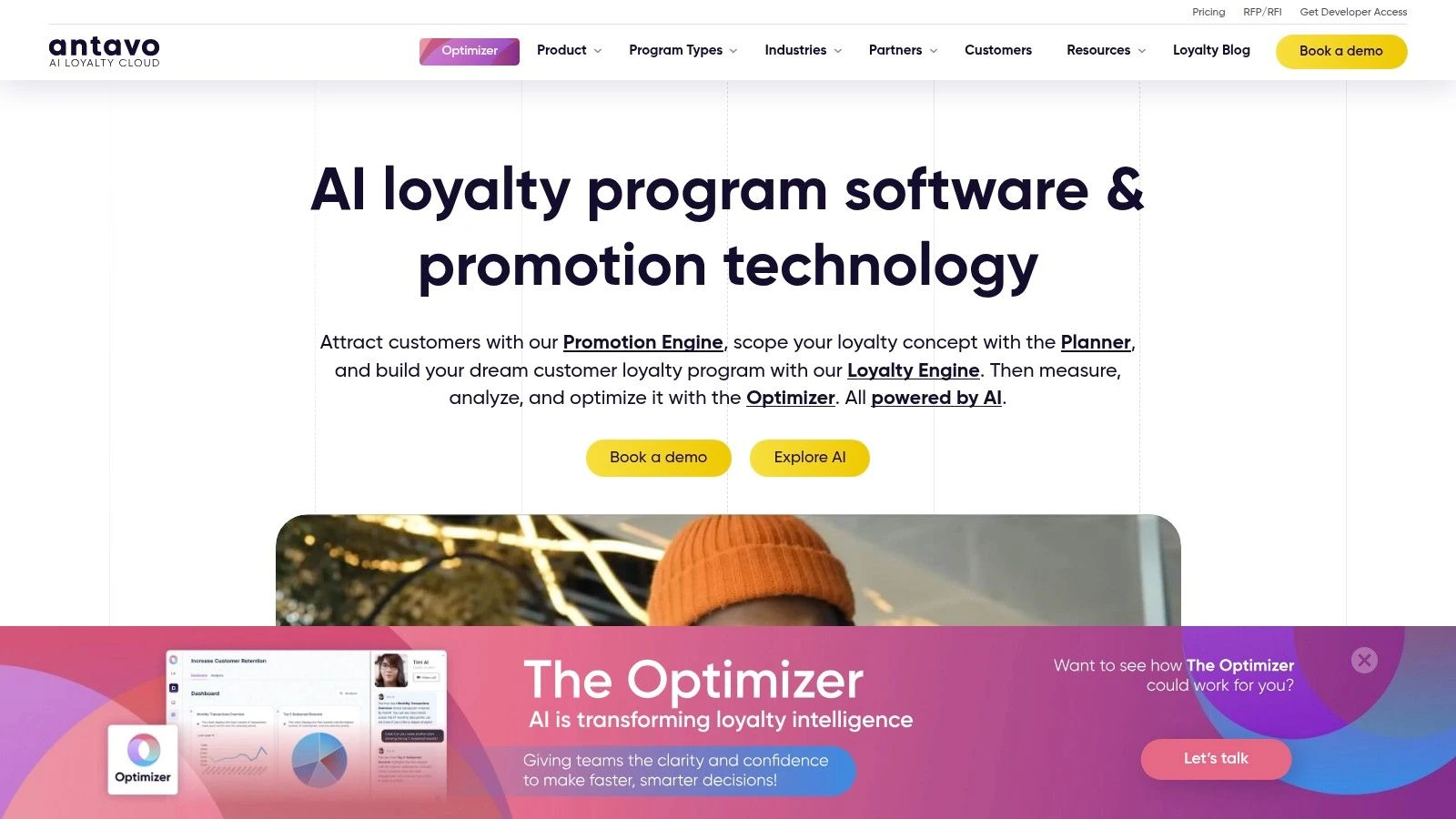
This platform is engineered for brands that view loyalty as a core part of their marketing strategy, not just an add-on. Antavo’s suite, which includes a Planner, Promotion Engine, Loyalty Engine, and Optimizer, allows marketers to design intricate campaigns. The API-first architecture provides the flexibility to integrate with complex tech stacks, and its AI-assisted tools help in planning and optimizing promotions for maximum impact, solidifying its place among the best retail loyalty programs for innovative brands.
Key Features and Considerations
Antavo excels at enabling retailers to reward customers for behaviors beyond just spending money. For example, a fashion brand could create a challenge where members earn bonus points for sharing a photo of their outfit on social media, writing a product review, or attending an exclusive in-store event. This creates a more engaging and community-driven experience that builds brand advocacy.
Pros:
- Flexible for Experiential Loyalty: Strong focus on non-transactional and lifestyle-based rewards beyond discounts.
- Advanced Mechanics: Highly configurable with a powerful promotion engine for complex campaigns.
- API-First Architecture: Built for seamless integration with modern, composable commerce stacks.
Cons:
- Pricing Not Public: Requires direct consultation and is geared toward enterprise-level budgets.
- Smaller US Integrator Network: Its partner ecosystem in the US is less extensive than that of larger suite vendors.
Website: https://antavo.com/
9. Yotpo Loyalty & Referrals
Yotpo Loyalty & Referrals is a powerful solution for direct-to-consumer (DTC) brands that want a loyalty program deeply integrated with their broader marketing efforts. Its core strength lies in being part of the wider Yotpo retention suite, which includes reviews, SMS marketing, subscriptions, and visual user-generated content. This allows retailers to create a cohesive retention strategy, rewarding customers for actions like leaving a review or subscribing to SMS updates, all within one unified platform.

This integrated approach makes Yotpo one of the best retail loyalty programs for merchants on platforms like Shopify and Shopify Plus who are already leveraging other Yotpo products. The platform supports a variety of loyalty models, including points, VIP tiers, paid memberships, and referral programs. For brands with a physical presence, its receipt upload feature enables an omnichannel experience by allowing customers to earn points for in-store purchases.
Key Features and Considerations
Yotpo excels at connecting loyalty with customer engagement. A brand can, for instance, automatically award loyalty points to a customer who leaves a five-star review, then follow up with a targeted SMS campaign offering a bonus for their next purchase. This creates a powerful feedback loop that drives both engagement and repeat business. The platform's admin tools and analytics provide clear insights into program performance, with multi-store options available for growing brands.
Pros:
- Unified Retention Stack: Seamless integration across reviews, SMS, subscriptions, and loyalty creates a cohesive customer experience.
- Strong DTC Focus: Extremely popular among modern ecommerce brands with a robust partner ecosystem and deep Shopify integration.
- Omnichannel Capabilities: Receipt upload functionality helps bridge the gap between online and offline retail.
Cons:
- Quote-Based Pricing: Costs can be less transparent and may increase significantly when bundling multiple Yotpo modules.
- Ecommerce-Centric: While it offers omnichannel features, the platform is primarily built for ecommerce rather than complex brick-and-mortar POS systems.
Website: https://www.yotpo.com/use-cases/product/loyalty/
10. Smile.io
Smile.io is a popular, easy-to-launch loyalty app designed specifically for SMB and mid-market ecommerce merchants, with deep integrations into platforms like Shopify, BigCommerce, and Wix. It excels at providing a fast and straightforward path to launching a loyalty program, offering a combination of points, referrals, and VIP tiers. Its core strength is its simplicity and ecommerce-first focus, making it a go-to choice for direct-to-consumer brands that need a functional rewards system without a complex, months-long implementation.
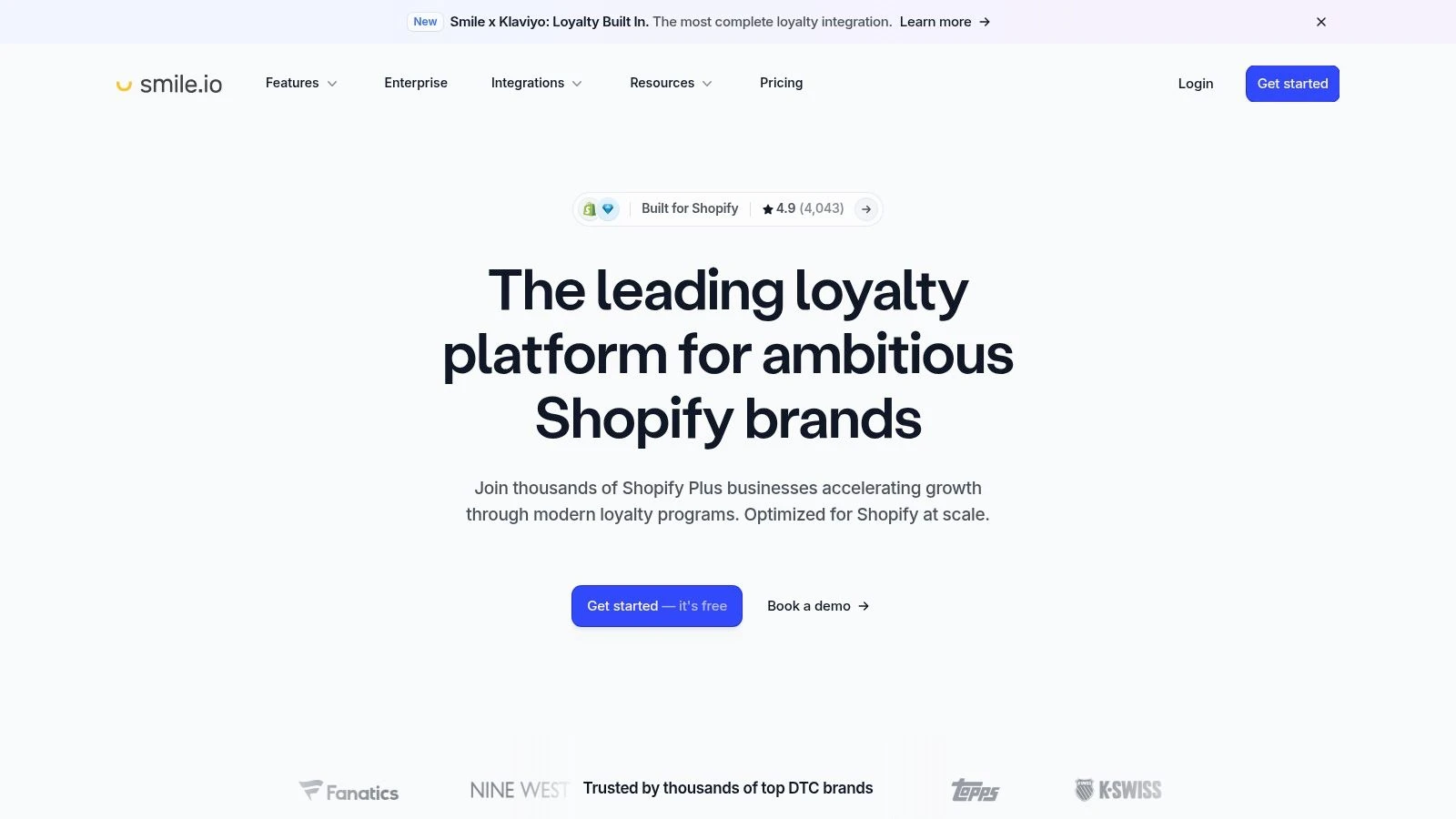
Unlike enterprise-level systems, Smile.io offers transparent, tiered pricing, including a free plan for new businesses. This accessibility makes it one of the best retail loyalty programs for startups and growing online stores. Its prebuilt widgets and on-site "nudges" can be deployed in minutes, encouraging customers to engage with the program right away. The platform also includes Shopify POS support, allowing for basic earn-and-redeem functions in a physical retail setting.
Key Features and Considerations
The platform is built for speed and ease of use, empowering merchants to quickly set up campaigns like "double points weekends" or birthday rewards. Integrations with key ecommerce tools like Klaviyo for email marketing and Judge.me for reviews allow brands to automatically award points for actions beyond just purchases. For those just starting, learning how to create a rewards program that boosts loyalty is made much simpler with Smile.io's intuitive interface and clear setup guides.
Pros:
- Very Fast Deployment: Can be set up and running in under an hour on supported platforms.
- Predictable Pricing: Clear, public pricing with a free entry-level tier scales with merchant growth.
- Strong Ecommerce Focus: Excellent integrations and features tailored for online-first retailers.
Cons:
- Limited Omnichannel Support: Primarily built for ecommerce and lacks features for complex multi-location or partner programs.
- Feature Limits on Lower Tiers: Essential features and integrations may require higher-tier plans, and overage fees can apply.
Website: https://smile.io/
11. G2 - Loyalty Management Software Category
G2's Loyalty Management Software category is not a single platform but an essential research marketplace for any business evaluating retail loyalty programs. It aggregates hundreds of verified user reviews, data points, and comparison tools, allowing decision-makers to create a shortlist based on real-world feedback rather than just vendor marketing. This resource is particularly valuable for filtering solutions by company size, from small businesses to large enterprises, ensuring the options are relevant to your operational scale.
Unlike a direct vendor website, G2 provides an aggregated, third-party perspective. Its Grid reports visually map out market leaders, contenders, and niche players based on user satisfaction and market presence. This allows you to quickly identify top-rated platforms and compare their features side-by-side, balancing vendor claims with the actual experiences of their customers.
Key Features and Considerations
The platform's true power lies in its detailed user reviews and filtering capabilities. You can drill down into specific industries, read in-depth feedback on implementation and customer support, and see how different tools are rated for specific features. This granular insight helps you validate whether a potential solution truly aligns with your needs. While G2 is a great starting point for market research, many find it helpful to consult curated lists like our guide to the 12 best loyalty apps for small businesses in 2025 to narrow their focus even further.
Pros:
- Broad Vendor Coverage: Provides a comprehensive overview of the loyalty software market.
- Current User Feedback: Access to recent, verified reviews helps validate vendor claims.
- Helpful for Shortlist Creation: Excellent for initial research and identifying top contenders.
Cons:
- Sponsored Placements: Be aware that some vendor placements and ads are paid for.
- Requires Further Vetting: Ratings are a starting point; always validate fit with demos and references.
Website: https://www.g2.com/categories/loyalty-management
12. Capterra - Customer Loyalty Software Category
Capterra's Customer Loyalty Software category is not a loyalty program itself, but an essential research hub for retailers searching for one. It functions as a comprehensive software directory, aggregating dozens of loyalty platforms and presenting them in a comparable format. This resource is invaluable for small to medium-sized businesses that need to efficiently survey the market, compare features, and read user-generated reviews before committing to a solution.
Its core value lies in its filtering and comparison tools. Users can quickly narrow down the best retail loyalty programs by features like rewards management, tier levels, or mobile app compatibility. This allows a business owner to create a shortlist of vendors that meet their specific operational needs without having to visit dozens of individual websites, saving significant research time.
Key Features and Considerations
The platform excels at providing at-a-glance information, especially pricing notes and feature checklists, which are often difficult to find on vendor sites. For instance, a coffee shop owner can filter for solutions with punch card features and POS integrations, then scan user reviews to gauge real-world performance. While Capterra offers a broad overview, it is best used as a starting point; direct verification with vendors is crucial for accurate pricing and implementation details.
Pros:
- Easy Comparison: Feature matrices and filters allow for quick, side-by-side evaluation of multiple tools.
- Broad Coverage: Includes a wide range of solutions, from SMB-focused apps to enterprise-level platforms.
- User Reviews: Provides authentic feedback from actual users, offering insights beyond marketing materials.
Cons:
- Data Can Be Outdated: Pricing and feature information is often vendor-submitted and may not be current.
- Lacks Implementation Depth: Reviews typically focus on usability rather than complex enterprise integration challenges.
Website: https://www.capterra.com/customer-loyalty-software/
Top 12 Retail Loyalty Programs Comparison
| Product | Core features | UX & Quality | Value & Price | Target audience | Unique selling points |
|---|---|---|---|---|---|
| 🆠BonusQR | Stamp cards, points, cashback, visit rewards, automated coupons, analytics ✨ | ★★★★ fast setup, QR mobile/web scan | 💰 Free; €19/mo; €69/mo; White‑Label €690+; Custom ~€1690+ | 👥 Small businesses: cafés, restaurants, salons, gyms, retail | ✨ No hardware, modular programs, built‑in marketing & real‑time analytics |
| Salesforce Loyalty Management | Points, tiers, partner programs, CRM analytics | ★★★★★ enterprise-grade, native CRM | 💰 High; published enterprise pricing | 👥 Multi-brand retailers, orgs on Salesforce | ✨ Deep Salesforce integration, SI partner ecosystem |
| Oracle CrowdTwist Loyalty & Engagement | Omnichannel earning, gamification, rewards catalog, member portals | ★★★★ mature enterprise platform | 💰 Quote-based enterprise pricing | 👥 Large retailers, brands using Oracle CX | ✨ Strong Oracle CX/Unity integrations, BI dashboards |
| SAP Emarsys Customer Engagement | AI segmentation, real-time personalization, native loyalty | ★★★★ marketing-centric, quick tactics | 💰 Quote-based, modular pricing | 👥 Retail marketers, mid‑enterprise | ✨ Prebuilt retail playbooks + loyalty orchestration |
| PAR Punchh (PAR Engagement - Loyalty) | Points/tiers, gamification, open APIs, wallet support | ★★★★ mobile-first UX, deep POS integrations | 💰 Enterprise sales motion; pricing not public | 👥 QSR & convenience retail chains (US) | ✨ Proven at scale for restaurants, strong mobile UX |
| Paytronix | Loyalty, offers, ordering, CRM, subscriptions, payments | ★★★★ integrated stack, real-time ROI & cohorts | 💰 Quote-based; modular | 👥 Foodservice & c‑store operators | ✨ Combines loyalty + ordering + CRM into one platform |
| Annex Cloud (Loyalty Experience Platform) | Rules engine, omnichannel earning, referrals, 125+ integrations | ★★★★ enterprise‑grade, highly configurable | 💰 Quote-based; implementation effort | 👥 Retail & CPG, multi-region programs | ✨ Advanced gamification, extensive connector ecosystem |
| Antavo Loyalty Cloud | Planner, promotion engine, loyalty engine, AI tools | ★★★★ flexible for experiential programs | 💰 Quote-based; enterprise implementation | 👥 Retail, fashion & specialty brands | ✨ Experiential rewards, API‑first & AI-assisted planning |
| Yotpo Loyalty & Referrals | Points, VIP tiers, referrals, receipt upload, ecommerce integrations | ★★★★ unified retention UX for ecommerce | 💰 Quote-based; bundled pricing possible | 👥 Shopify/Shopify Plus, DTC & ecommerce brands | ✨ Loyalty + reviews + SMS unified retention stack |
| Smile.io | Points, referrals, VIP tiers, prebuilt widgets | ★★★★ very fast deployment, user-friendly | 💰 Free tier; transparent paid plans | 👥 SMB & mid-market ecommerce merchants | ✨ Predictable pricing, quick Shopify/Wix integration |
| G2 - Loyalty Management Software Category | Category rankings, user reviews, buyer guides, comparisons | ★★★ review-driven insights, real-user feedback | 💰 Free to use; helps shortlist vendors | 👥 Buyers researching loyalty platforms | ✨ Up-to-date reviews, Grid reports & filters |
| Capterra - Customer Loyalty Software Category | Listings, pricing snippets, feature filters, vendor links | ★★★ directory-style UX, easy scanning | 💰 Free to use; pricing callouts (verify) | 👥 SMBs & buyers comparing options | ✨ Quick pricing/feature scans and vendor links |
Choosing Your Loyalty Partner: A Final Checklist
We've explored a wide landscape of the best retail loyalty programs, from enterprise-level powerhouses like Salesforce and Oracle to nimble, e-commerce-focused solutions such as Yotpo and Smile.io. The journey through these platforms reveals a clear truth: there is no single "best" solution for everyone. The right choice is deeply personal to your business, your customers, and your growth strategy.
The core takeaway is that modern loyalty is far more than a simple punch card. It's about data, personalization, and creating an integrated customer experience that transcends transactions. Platforms like PAR Punchh and Paytronix demonstrate the power of combining loyalty with ordering and payment systems, while tools like Antavo and Annex Cloud showcase the potential of sophisticated, tiered reward structures and experiential benefits.
Ultimately, your selection process should be a strategic exercise, not just a feature comparison. The ideal program will not only reward repeat business but also provide you with the actionable data needed to understand customer behavior and make smarter marketing decisions.
Key Factors to Guide Your Decision
As you move from evaluation to decision, distill your needs by focusing on these critical areas. Revisit your top contenders and measure them against this final checklist to ensure you're making a well-rounded choice.
Business Model & Scale: Are you a single-location coffee shop or a multi-unit franchise? A high-volume e-commerce store needs different tools than a service-based salon. Your current size and future growth plans will dictate whether you need a scalable enterprise solution like SAP Emarsys or a more accessible platform like BonusQR or Smile.io.
Integration Capabilities: A loyalty program that doesn't talk to your other systems is a data silo waiting to happen. Prioritize platforms that offer seamless, pre-built integrations with your existing Point of Sale (POS), e-commerce platform (like Shopify or BigCommerce), and email marketing software. This is non-negotiable for a unified customer view.
Customer Experience: How will your customers interact with the program? A clunky, confusing interface will kill adoption. Consider the ease of sign-up, point tracking, and reward redemption. Is a physical card necessary, or will a digital-first, QR-code-based system provide a smoother, more modern experience for your clientele?
Total Cost of Ownership: Look beyond the monthly subscription fee. Factor in potential implementation costs, transaction fees, charges for exceeding contact or member limits, and the cost of any necessary third-party integrations. A seemingly cheaper plan can become expensive once you account for the full ecosystem.
Your Actionable Next Steps
Feeling overwhelmed by the options is normal. The key is to move forward with a clear, methodical plan. Here’s how to proceed from here:
Define Your Goals: Before you schedule a single demo, write down what you want to achieve. Is it to increase visit frequency by 15%? Boost average order value? Or simply to collect customer data for better marketing? Concrete goals will be your North Star.
Shortlist 2-3 Candidates: Based on your goals and the insights from this article, narrow your list down to a maximum of three platforms. Use the G2 and Capterra listings we mentioned to read recent user reviews for your top picks.
Request Personalized Demos: A generic video tour isn't enough. Schedule live demos and come prepared with a list of questions specific to your business. Ask them to show you exactly how the platform would handle a key use case for your retail or restaurant environment.
Launch a Pilot Program: If possible, inquire about a trial period or a phased rollout. You could test the new loyalty program with a small segment of your most loyal customers first. This allows you to gather feedback and work out any kinks before a full-scale launch.
Choosing from the best retail loyalty programs is a significant investment in your customer relationships. By focusing on your specific needs, prioritizing seamless integration, and planning a deliberate implementation, you can select a partner that will not just retain customers, but turn them into passionate advocates for your brand.
For small businesses, restaurants, and salons seeking a straightforward yet powerful solution, BonusQR offers a compelling starting point. It simplifies the entire process with an easy-to-use digital punch card system, helping you launch your program quickly without the complexity or high cost of enterprise software. See if its QR-code-based approach is the perfect fit for your business at BonusQR.
